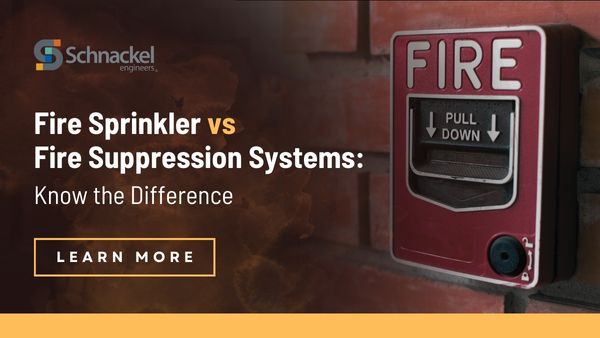Fire Sprinkler vs Fire Suppression Systems: Know the Difference

In fire safety, two systems are commonly used to protect lives and property: fire sprinkler systems and fire suppression systems. While both are designed to control or extinguish fires, they work in different ways and are used in different settings. Understanding the difference is key to choosing the right solution for your building.
In this blog, we’ll break down how fire sprinkler and fire suppression systems compare. By the end, you’ll understand the main differences, the pros and cons of each, and where each system is the best fit. Let’s start with the basics of how each system works.
Fire Sprinkler Systems
Fire sprinkler systems are a time-tested and widely used method of fire protection. These systems consist of a network of pipes and strategically placed sprinkler heads throughout a building. Each sprinkler head is equipped with a heat-sensitive element that triggers a release of water when the temperature rises due to a fire.
Key Features of Fire Sprinkler Systems:
- Automatic Activation: Fire sprinklers activate individually when the heat from a fire raises the temperature at a specific sprinkler head, causing it to release water.
- Coverage: Sprinkler systems provide broad coverage, making them suitable for open spaces or buildings with multiple rooms.
- Suppression Agent: Water is the primary suppression agent used in these systems, which can lead to potential water damage to property and equipment.
Fire Suppression Systems
Fire suppression systems offer an alternative approach to fire control. These systems employ specialized agents such as foam, gas, or chemicals to suppress or extinguish fires.
Key Features of Fire Suppression Systems:
- Central Activation: Suppression systems typically rely on a central control panel to detect fires and release suppression agents throughout the protected area.
- Targeted Suppression: These systems excel at extinguishing specific types of fires without causing water damage, making them ideal for safeguarding valuable equipment and sensitive areas.
- Suppression Agent: Suppression systems use a variety of agents, which can include non-toxic gases, foams, or chemicals, depending on the type of fire being addressed.
Key Differences between Fire Sprinkler and Fire Suppression Systems
Now that we have a basic understanding of each system let’s delve into the key differences:
- Activation Method:
- Fire Sprinkler Systems: Activation is individual, with each sprinkler head responding to localized heat.
- Fire Suppression Systems: Activation is centralized, triggered by a control panel’s detection of a fire.
- Coverage:
- Fire Sprinkler Systems: Designed for broad coverage, suitable for open spaces and multi-room buildings.
- Fire Suppression Systems: Provide targeted protection, ideal for safeguarding specific assets or areas.
- Suppression Agent:
- Fire Sprinkler Systems: Use water as the primary suppression agent, potentially causing water damage.
- Fire Suppression Systems: Employ various agents, minimizing water damage while effectively addressing specific fire types.
Advantages and Disadvantages
Let’s weigh the pros and cons of each system:
Fire Sprinkler Systems:
Pros:
- Reliable Activation: Sprinklers activate automatically, minimizing response time and potential damage.
- Cost-Effective: Generally more budget-friendly to install and maintain.
- Coverage: Provide broad coverage, suitable for a wide range of applications.
Cons:
- Water Damage: May result in water damage, especially in sensitive environments.
- Limited Suppression: Designed to control fires until the fire department arrives, not fully extinguishing all fire types.
Fire Suppression Systems:
Pros:
- Targeted Suppression: Excel at extinguishing specific types of fires without causing water damage.
- Minimal Water Damage: Do not use water, avoiding water damage altogether.
- Versatility: Suitable for specialized applications and sensitive environments.
Cons:
- Installation Costs: Often more expensive to install and maintain.
- Limited Coverage: Best suited for safeguarding specific areas rather than entire buildings.
Conclusion
In conclusion, the choice between fire sprinkler vs. fire suppression systems depends on various factors, including the nature of the building, its contents, and specific fire safety requirements. By understanding the key differences and weighing the pros and cons of each system, you can make informed decisions tailored to your unique needs.
When it comes to ensuring fire safety and protection, Schnackel Engineers, Inc. is your trusted partner. Whether you opt for a fire sprinkler system or a fire suppression system, we provide exceptional quality and value on every project. Secure your property’s future today—contact us to discuss your fire protection needs and take the first step towards a safer and more secure environment. Your safety is our priority.
Gain deeper insights into fire protection. Explore our comprehensive guide:
Fire Protection System Basics: A Guide for Building Owners & Architects
Comments